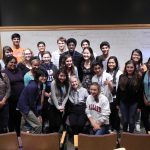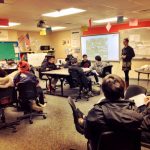
Imagine. Design. Fabricate.
“We are muddy boots on the ground, slogging through it every day working to make a difference.”
These are the words of a visionary—a man with the mission to spread the wealth of design and fabrication knowledge to the communities who have traditionally had the least access to it. Part of a larger network of design-thinkers and makers around the world, Nathan Pritchett is the Executive Director of Fab Lab Tulsa, a creative space where schools, businesses, and individuals can learn and practice the dynamic of design thinking. As he says, “…design and fabrication never end—iteration, versions, product planning. You go around in a circle and never end.”
The mission statement is more formal: “The mission of Fab Lab Tulsa is to better our community by assuring access to 21st Century tools, equipment, technology, and resources. Fab Lab Tulsa provides community access to advanced manufacturing and digital fabrication tools for learning skills, developing inventions, creating business, and producing personalized products.”
Such tools include computers with CAB/CAM software, CNC machinery, 3D printers, and other power and hand tools. The lab’s call to action is “Imagine. Design. Fabricate.” These tools make it possible.
The process that created Fab Lab Tulsa began in 2008. They moved into their 3700 square-foot space in one of the poorer sections of Tulsa two years ago. Their location was deliberate: “This lab in another part of town doesn’t have the same impact,” Pritchett says.
Last year the lab was host to 2600 kids, many of whom came with their classroom teachers. Lab personnel start them off with a problem to solve, teach them how to use the machines, and then work alongside them as their teams generate solutions to the problem, pick the best one, and then build it. Pritchett describes the work: “We start off as teachers but then move to collaborators.” Thus, the students own the process and the product.
This winter, a group of 7th graders from McLain Junior High were part of a 14-week design-build project that began with the problem of how to build the most efficient human powered vehicle. “This group of kids worked great as individuals and teams,” said Pritchett. “They were remedial kids who hadn’t had algebra. They intuitively know math but it just hasn’t been explained the right way in a way they can understand.”
The Fab Lab concept grew out of the work of Professor Neil Gershenfeld, head of MIT’s Center for Bits and Atoms (CBA). CBA charters the 117 labs in 30 countries—a global community with an agenda of transformation by putting the tools of change into the hands of local communities and practitioners. The Fab Academy is the educational wing of the effort—a global campus. It provides access to the knowledge base needed to participate in the fab lab world.
A central tenet of the fab lab community is that the work in each lab is public and the various labs work to support each other’s projects. Thus, at the Norwegian lab when farmers and engineers collaborating on a wireless radio network to track sheep and reindeer built an antenna, they posted photos and instructions on the web for others to see.
Gershenfeld is quite clear on the democratization function of fab labs when he talks about the underrepresentation of women and minorities in STEM fields: “Digital fabrication offers a new response to this need, starting at the beginning of the pipeline. Children can come into any of the fab labs and apply the tools to their interests. The Fab Academy seeks to balance the centralized enthusiasm of the do-it-yourselfer maker movement and the mentorship that comes from doing it together. After all, the real strength of a fab lab is not technical; it is social.”
Imagine the implications of this value system applied to fab labs around the world. Not only are they places to empower kids to explore technology or to give adults a chance to try out new designs for business ideas or for individuals to build things that interest them. They can also empower rural, developing communities by giving residents the ability to design and create the tools they need to solve local problems. The transformative powers of “human-centered design” are endless.
By Pamela Wise
Related Links
-
FabLab Tulsa – http://www.fablabtulsa.com/
-
Design Thinking for Educators (IDEO) – http://designthinkingforeducators.com
-
Virtual Crash Course in Design Thinking (Stanford) – http://dschool.stanford.edu/dgift/





